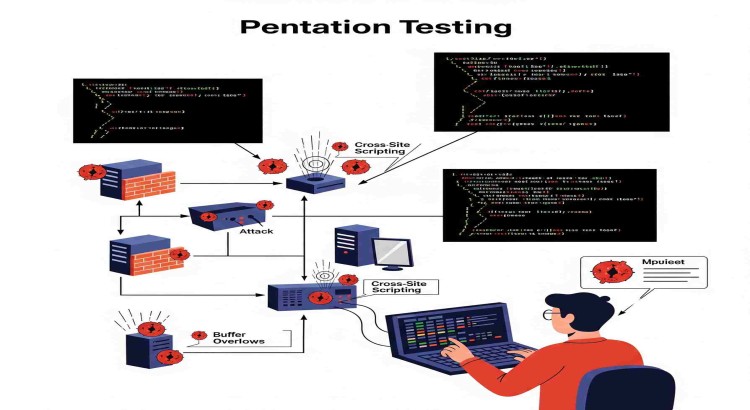
Comprehensive Vulnerability Assessment & Penetration Testing (VAPT)
Overview:
In an increasingly hostile cyber landscape, simply reacting to threats is no longer sufficient. To truly protect your digital assets, you need to proactively identify and remediate weaknesses before malicious actors exploit them. This offer is meticulously designed for organizations committed to fortifying their defenses through a rigorous and comprehensive Vulnerability Assessment and Penetration Testing (VAPT) program. With over a decade of specialized experience in cybersecurity, I provide a deep dive into your systems, applications, and networks to uncover hidden vulnerabilities, simulate real-world attacks, and provide actionable insights for remediation. By identifying and addressing these weaknesses proactively, you can significantly reduce your attack surface, enhance your security posture, meet compliance requirements, and safeguard your reputation, ensuring business continuity in the face of evolving cyber threats.
Tools & Skills:
- Vulnerability Scanners: Nessus, Qualys, OpenVAS, Acunetix, Burp Suite Professional (for web app scanning)
- Penetration Testing Frameworks: Metasploit Framework, Kali Linux tools (Nmap, Hydra, John the Ripper)
- Web Application Security: OWASP ZAP, Burp Suite Professional, SQLMap
- Network Security: Wireshark, tcpdump, Snort/Suricata (for traffic analysis)
- Operating Systems: Windows, Linux (for target systems and attack platforms)
- Scripting: Python, Bash (for custom exploits and automation)
- Social Engineering (Awareness): Understanding common social engineering tactics.
- Reporting: Detailed, actionable reports with risk ratings and remediation steps.
- Compliance: Understanding of PCI DSS, HIPAA, GDPR, ISO 27001 requirements for VAPT.
- Cloud Security (Basic): Understanding cloud security configurations for VAPT in cloud environments.
- Red Teaming Principles: Applying attacker methodologies to uncover weaknesses.
How I Work:
My VAPT methodology is systematic, ethical, and tailored to your specific environment, adhering to industry best practices:
Scope Definition & Planning:
- Initial Consultation: A detailed discussion to understand your business objectives, critical assets, regulatory requirements, and the scope of the VAPT engagement (e.g., external network, internal network, web applications, specific systems).
- Asset Identification: Identifying all in-scope systems, applications, IP ranges, and domains.
- Rules of Engagement (RoE): Formalizing the testing methodology, timing, communication protocols, and emergency contacts to ensure a safe and controlled test.
- Project Plan: Development of a detailed project plan with timelines, milestones, and deliverables.
- Client Approval: Formal approval of the scope and rules of engagement before any testing begins.
Information Gathering & Reconnaissance:
- Passive Reconnaissance: Gathering publicly available information about your organization, network, and applications (e.g., DNS records, open-source intelligence).
- Active Reconnaissance: Scanning and probing in-scope systems to identify open ports, services, operating systems, and potential entry points.
Vulnerability Assessment (VA):
- Automated Scanning: Utilizing industry-leading vulnerability scanners (e.g., Nessus, Qualys) to identify known vulnerabilities across your network, servers, and applications.
- Manual Verification: Manually verifying findings from automated scans to eliminate false positives and confirm the existence of vulnerabilities.
- Configuration Review: Reviewing system and application configurations for security misconfigurations.
Penetration Testing (PT):
- Exploitation: Attempting to exploit identified vulnerabilities to gain unauthorized access, elevate privileges, or exfiltrate data, simulating a real-world attack.
- Post-Exploitation: If successful, demonstrating the potential impact of a breach (e.g., lateral movement, data access) without causing harm.
- Web Application Testing: Performing tests against web applications for common vulnerabilities like SQL Injection, XSS, CSRF (OWASP Top 10).
- Network Penetration Testing: Assessing network devices, firewalls, and internal systems for weaknesses.
- Privilege Escalation: Attempting to gain higher levels of access within compromised systems.
Reporting & Remediation Guidance:
- Detailed Technical Report: A comprehensive report detailing all identified vulnerabilities, their severity (CVSS scores), potential impact, and clear, actionable remediation steps.
- Executive Summary: A high-level overview for management, highlighting key risks and business impact.
- Proof of Concept (PoC): Providing evidence (e.g., screenshots, logs) for exploited vulnerabilities.
- Remediation Workshop: A dedicated session to walk your team through the findings and provide guidance on remediation strategies.
Retesting & Verification (Optional/Add-on):
- Remediation Verification: After you've applied fixes, I can perform retesting to confirm that vulnerabilities have been successfully remediated.
Why Choose Me?
- 10+ Years of Cybersecurity Expertise: Extensive experience in VAPT across diverse industries and complex environments.
- Proactive Threat Identification: I don't just find vulnerabilities; I simulate attacks to show you how they can be exploited.
- Actionable Insights: My reports are clear, concise, and provide practical, prioritized steps for remediation.
- Ethical Hacking Principles: All testing is conducted ethically, securely, and with strict adherence to the agreed-upon scope.
- Compliance Support: My VAPT services help you meet various regulatory and industry compliance requirements.
- Reduced Risk & Enhanced Security: By addressing weaknesses before they are exploited, you significantly reduce your organization's cyber risk.
